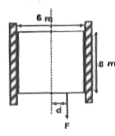Find the maximum distance 'd' from the horizontal centre line of the drawer at which the force F may be applied and still allow the drawer to be opened without binding at the corner. Neglect friction on the bottom of drawer and take the coefficient of static friction between the both sides of the drawer and the tube to be equal to two (μ=2).

1.5m
2m
3m
1.2m
The correct Answer is:B
Topper's Solved these Questions
- KINEMATICSBook:FIITJEEChapter:KINEMATICSExercise:SECTION (II) : (SUBJECTIVE )
Explore 33 Videos
- KINEMATICSBook:FIITJEEChapter:KINEMATICSExercise:SECTION(II) : MCQ ( SINGLE CORRECT)
Explore 47 Videos
- KINEMATICSBook:FIITJEEChapter:KINEMATICSExercise:NUMERICAL BASED QUESTIONS
Explore 3 Videos
- HEAT AND TEMPERATUREBook:FIITJEEChapter:HEAT AND TEMPERATUREExercise:NUMERICAL BASES QUESTIONS
Explore 1 Video
- LAWS OF MOTIONBook:FIITJEEChapter:LAWS OF MOTIONExercise:COMPREHENSION-III
Explore 2 Videos
Similar Questions
Determine the maximum ratio h/b for which the homogenous block will side without tipping under the actionof force P. The coefficient of static friction between the block and the incline is μs.

View SolutionDetermine the maximum ratio h/b for which the homogenous block will side without tipping under the actionof force P. The coefficient of static friction between the block and the incline is μs.

View SolutionA car has to move on a level turn of radius 45 m. If the coefficient of static friction between the tire and the road is μs=2.0, find the maximum speed the car can take without skidding.
View SolutionA car has to move on a level turn of radius 45 m. If the coefficient of static friction between the tyre and the road is μs=2.0, find the maximum speed the car can take without skidding.
View SolutionA body is filled quasi statically to the top of a mountain through path 1 and path 2 by applying a force from bottom in the figure. Coefficient of friction between the body and surface is μ then

View SolutionConsider the situation shown in the figure . The coefficient of friction between the blocks is μ. Find the minimum and the maximum force F that can be applied so that two blocks move together.

View SolutionA uniform solid cylinder of mass m rests on two horizontal planks. A thread is wound on the cylinder. The hanging end of the thread is pulled vertically down with a constant force F.

Find the maximum magnitude of the force F which may be applied without bringing about any sliding of the cylinder, if the coefficient of friction between the plank and the cylinder is equal to μ. What is the maximum acceleration of the centre of mass over the planks?
View SolutionA uniform solid cylinder of mass m rests on two horizontal planks. A thread is wound on the cylinder. The hanging end of the thread is pulled vertically down with a constant force F.

Find the maximum magnitude of the force F which may be applied without bringing about any sliding of the cylinder, if the coefficient of friction between the plank and the cylinder is equal to μ. What is the maximum acceleration of the centre of mass over the planks?
View SolutionA prismatic block of mass m is kept on a groove . The bottom line of the groove makes an angle θ with horizontal . The angle between the flat surface 1 and 2 making the groove is ϕ If the groove is symmetrical with the normal to the inclined plane containing the bottom line of the groove

a. Find the coefficient of friction μ0 between the block and groove so that the block begins to slide.
b. If μ>μ0 find the friction force on the block.
c. If μ<μ0 find the acceleration of the block.
View SolutionDetermine the maximum horizontal force F that may be applied to the plank of mass m for which the solid sphere does not slip as it begins to roll on the plank. The sphere has a mass M and radius R. The coefficient of static and kinetic friction between the sphere and the plank are μsandμk respectively.

View Solution
